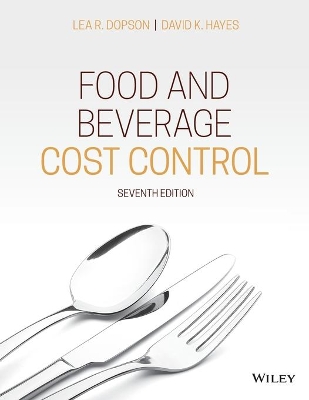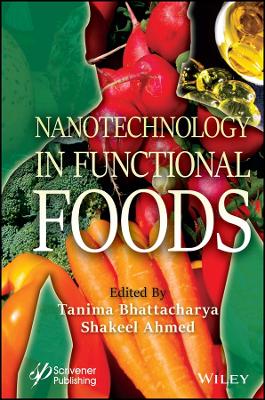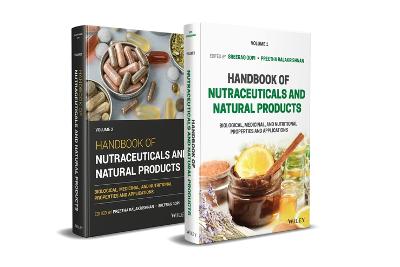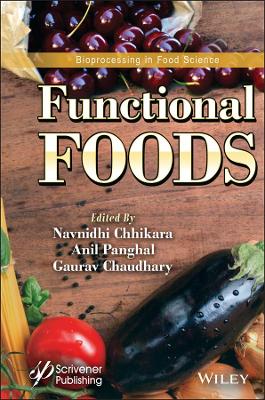Probiotic Ice Cream
 -10%
portes grátis
-10%
portes grátis
Probiotic Ice Cream
Science and Technology
Homayouni-Rad, Aziz
John Wiley & Sons Inc
12/2024
272
Dura
Inglês
9781119081166
Pré-lançamento - envio 15 a 20 dias após a sua edição
Descrição não disponível.
Preface xv
Biography xvii
Part I The Science of Probiotic Ice Cream 1
1 Ice Cream and Frozen Dairy Desserts: Classification and History 3
1.1 History of Ice Cream Making 3
1.2 Definition of Ice Cream 4
1.3 Classification of Ice Cream 5
1.3.1 Regular Ice Cream Types 8
1.3.2 Chocolate Ice Cream 10
1.3.3 Fruit Ice Cream 11
1.3.4 Nutty Ice Cream 12
1.3.5 Yoghurt Ice Cream 13
1.3.6 Puddings 15
1.3.7 Special Ice Creams 16
1.3.8 Other Types of Ice Cream 18
References 22
2 Probiotics: Definition and Characterization 23
2.1 Introduction 23
2.2 Definition of Probiotics 25
2.3 Types of Probiotics 28
2.3.1 Lactobacillus Genus 29
2.3.1.1 Lactobacillus acidophilus 31
2.3.1.2 Lactobacillus casei 31
2.3.2 Genus Bifidobacterium 32
2.3.2.1 Bifidobacterium lactis 33
2.3.2.2 Bifidobacterium longum 34
2.3.3 Other Lactic Acid Bacteria 34
2.3.4 Nonlactic Acid Bacteria Probiotics 34
2.3.5 Probiotic Yeasts 34
2.4 Health-Promoting Effects of Probiotics 34
2.5 Necessity of Formulating Probiotic Ice Creams 35
2.6 Challenges in Production, Preservation, and Consumption of Probiotic Ice Cream 36
References 38
3 Selection of Appropriate Probiotic Strains for Use in Probiotic Ice Cream 39
3.1 Selection of Appropriate Probiotic Strains for Use in Probiotic Ice Cream 39
3.2 Effect of pH on Growth and Viability of Probiotics in Culture Media 40
3.3 Effect of Different Sucrose Concentrations on the Growth and Viability of Bacteria in the Culture Medium 46
3.4 Effect of Oxygen Scavengers on the Growth Index of Probiotics in the Culture Medium 53
3.5 Effect of Different Processing Temperatures on the Viability Index of Probiotics in the Culture Medium 57
3.6 Selecting Resilient Probiotic Species for Use in Ice Cream 63
3.7 Review of Researches on the Production of Functional Ice Cream 63
3.8 Investigating the Effects of Microencapsulation on the Viability of Probiotics in Various Food Products, Including Ice Cream 64
References 66
4 Physical Protection of Probiotics in Ice Cream Conditions 67
4.1 Encapsulation of Probiotic Bacteria for Use in Ice Cream 67
4.2 Encapsulation 69
4.2.1 Applications of Microencapsulation 70
4.2.2 Materials Used in Microencapsulation 72
4.2.2.1 Calcium Alginate 73
4.2.2.2 Resistant Starch 75
4.2.3 Methods of Encapsulation 77
4.2.3.1 Spray Drying Encapsulation 79
4.2.3.2 Centrifugal Nozzle Spraying Encapsulation 79
4.2.3.3 Emulsification-based Encapsulation 81
References 84
5 Nutritional Value of Functional Ice Cream 85
5.1 Nutritional Value of Ice Cream 85
5.1.1 Energy Content of Ice Cream 86
5.1.2 Caloric Content of Ice Cream 87
5.1.3 Protein Content in Ice Cream 89
5.1.4 Fat Content in Ice Cream 90
5.1.5 Carbohydrate Content in Ice Cream 90
5.1.6 Mineral Content in Ice Cream 92
5.1.7 Vitamins in Ice Cream 93
5.1.8 Digestibility of Ice Cream 93
References 94
Part II The Technology of Probiotic Ice Cream 95
6 Probiotic Ice Cream (Definition, Formulation, and Characterization) 97
6.1 Definition of Probiotic Ice Cream 97
6.2 Design of Probiotic Ice Cream 98
6.3 Probiotic Ice Cream Characterization 98
6.4 Technology of Probiotic Ice Cream Production 99
6.5 Adding Free and Microencapsulated Probiotic Bacteria into the Ice Cream 101
References 104
7 Prebiotic Ice Cream (Definition, Formulation, and Characterization) 105
7.1 Definition of Prebiotic Ice Cream 105
7.2 Prebiotics 105
7.2.1 Classifications of Prebiotics 106
7.2.1.1 Lactulose 106
7.2.1.2 Lactosaccharose 107
7.2.1.3 Isomalto-oligosaccharides 108
7.2.1.4 Xylo-oligo-saccharides 108
7.2.1.5 Fructo-oligosaccharides 109
7.2.1.6 Galacto-oligosaccharides 109
7.2.1.7 Soy Oligosaccharides 111
7.2.1.8 Resistant Starch 111
7.2.1.9 Dietary Fiber 112
7.3 Design of Prebiotic Ice Cream 113
7.4 Prebiotic Ice Cream Characterization 113
7.5 Technology of Prebiotic Ice Cream Production 114
References 115
8 Synbiotic Ice Cream (Definition, Formulation, and Characterization) 117
8.1 Definition of Synbiotic Ice Cream 117
8.2 Design of Synbiotic Ice Cream 118
8.3 Synbiotic Ice Cream Characterization 118
8.4 Technology of Synbiotic Ice Cream Production 118
References 120
9 Postbiotic Ice Cream (Definition, Formulation, and Characterization) 121
9.1 Definition of Postbiotic Ice Cream 121
9.2 Postbiotics 122
9.3 Design of Postbiotic Ice Cream 122
9.4 Postbiotic Ice Cream Characterization 123
9.5 Technology of Postbiotic Ice Cream Production 123
References 124
10 Functional Ice Cream (Ingredients and Processing) 127
10.1 Ice Cream Composition and Formulation 127
10.1.1 Total Solid Ingredients 127
10.1.2 Milk Fat 128
10.1.3 Milk Solids-Non-fat (MSNF) 130
10.1.4 Sweeteners 132
10.1.5 Stabilizers 133
10.1.6 Emulsifiers 138
10.1.7 Flavors and Colors 140
10.1.8 Water Content and Gases in Ice Cream 141
10.1.9 Optional Ingredients and Components in Ice Cream Formulation 141
10.2 Stages of Ice Cream Production 142
10.2.1 Mix Calculations 142
10.2.2 Preparing Ice Cream Mixture 147
10.2.3 Homogenization 148
10.2.4 Pasteurization 152
10.2.5 Aging of Mix 155
10.2.6 Aeration, Freezing, Packaging, and Hardening 156
References 169
11 Ice Cream as a Probiotic/Prebiotic Delivery Vehicle 171
11.1 Ice Cream as a Probiotic/Prebiotic Delivery Vehicle 171
11.2 Challenges Toward Adding Probiotics into Ice Cream 174
References 177
Part III Quality Control 179
12 Physicochemical, Rheological, and Microbial Properties of Probiotic Ice Cream 181
12.1 The Properties of Probiotic Ice Cream 181
12.2 Physical Properties 182
12.2.1 Surface Tension and Interfacial Tension 182
12.2.2 Stability 183
12.2.3 Density 184
12.2.4 Acidity 184
12.2.5 Surface Adsorption 185
12.2.6 Freezing Point 185
12.2.7 Ice Cream Melting Rate 185
12.2.8 Aeration Capability 187
12.3 Chemical Properties 187
12.3.1 Gel Formation 187
12.3.1.1 Gel Formation in Ice Cream 188
12.4 Rheological Properties 189
12.4.1 Apparent and True Viscosity 189
12.4.2 Determination of Rheological Properties 190
12.4.3 Factors Affecting the Viscosity of Ice Cream mix 192
12.4.4 Methods for Evaluating Ice Cream Mix Viscosity 192
12.4.5 Application of Mixture Viscosity in Freezer Design and Prediction of Final Product Quality 193
12.5 Microbial Properties of Ice Cream 193
12.6 Ice Cream Microstructure 194
12.6.1 Observation of Ice Cream Microstructure 195
12.6.2 Determination of Fat Structure in Ice Cream 195
12.6.3 Analysis of Images Obtained from Ice Cream Microstructure 196
12.7 Quality Control of Ice Cream in Practice 198
12.7.1 Physicochemical Controls 199
12.7.1.1 Measurement of Moisture and Dry Matter in Ice Cream 199
12.7.1.2 Measurement of Ice Cream Acidity 200
12.7.1.3 Measurement of Ice Cream Overrun 200
12.7.1.4 Measurement of Ice Cream Fat Percentage 201
12.7.1.5 Identification of the Type of Fat Used in Ice Cream 201
12.7.1.6 Sucrose Percentage Measurement 203
12.7.1.7 Measurement of MSNF in Ice Cream 203
12.7.2 Microbiological Controls 204
12.7.2.1 Preparation of Various Dilutions from Solid and Liquid Food Materials 205
12.7.2.2 Enumeration of Aerobic Bacteria 206
12.7.2.3 Enumeration of Coliform Bacteria 206
12.7.2.4 Enumeration of E. coli 207
12.7.2.5 Enumeration of Staphylococcus (Staph) 207
12.7.2.6 Enumeration of Mold and Yeast 208
12.7.2.7 Enumeration of Salmonella 208
12.7.2.8 Quantifying Probiotic Microorganisms in Probiotic Ice Cream 209
References 210
13 Sensory Properties of Probiotic Ice Cream 211
13.1 Sensory Evaluation of Ice Cream 211
13.1.1 Sensory Evaluation of Probiotic Ice Cream 213
13.1.2 Sensory Properties of Probiotic Ice Cream 214
13.2 Examination of Various Aspects of Ice Cream Quality 214
13.2.1 Taste 215
13.2.2 Body 217
13.2.3 Texture 218
13.2.4 Color 219
13.2.5 Appearance 219
13.2.6 Melting 220
13.2.7 Packaging 220
References 221
14 Shelf-Life Evaluation of Probiotic Ice Cream 223
14.1 Ice Cream Shelf Life 223
14.2 Factors Affecting Ice Cream Shelf Life 224
14.2.1 Raw Materials 225
14.2.1.1 Milk 225
14.2.1.2 Cream 226
14.2.1.3 Condensed Milk 226
14.2.1.4 Starter Culture 226
14.2.1.5 Fruits 227
14.2.1.6 Other Raw Materials 227
14.3 Shelf Life of Frozen Foods 227
14.3.1 Effect of Microorganisms 227
14.3.2 Movement of Ice Crystals in Food Systems 228
14.3.3 Physicochemical Reactions 228
14.3.4 Time-Temperature Tolerance (TTT) 229
14.3.5 PPP Factors (Product Quality, Processing, and Packaging) 229
14.3.6 Glass Transition State 229
14.3.7 Knowledge About the Product 230
14.3.8 Targeted Tests 230
14.3.9 Accelerated Tests 230
14.3.10 Cold Chain 231
14.4 Determining Shelf Life in Practice 233
14.4.1 Determining Shelf Life with Storage Tests 233
14.4.2 Ice Cream Shelf Life 234
14.4.2.1 Effect of Temperature Fluctuations and Ice Crystal Recrystallization on Shelf Life 234
14.4.2.2 Role of Stabilizers in Shelf Life 235
14.4.2.3 Role of Communication in Ice Cream Shelf Life 236
14.4.2.4 Methods to Increase Ice Cream Shelf Life 236
References 237
Index 239
Biography xvii
Part I The Science of Probiotic Ice Cream 1
1 Ice Cream and Frozen Dairy Desserts: Classification and History 3
1.1 History of Ice Cream Making 3
1.2 Definition of Ice Cream 4
1.3 Classification of Ice Cream 5
1.3.1 Regular Ice Cream Types 8
1.3.2 Chocolate Ice Cream 10
1.3.3 Fruit Ice Cream 11
1.3.4 Nutty Ice Cream 12
1.3.5 Yoghurt Ice Cream 13
1.3.6 Puddings 15
1.3.7 Special Ice Creams 16
1.3.8 Other Types of Ice Cream 18
References 22
2 Probiotics: Definition and Characterization 23
2.1 Introduction 23
2.2 Definition of Probiotics 25
2.3 Types of Probiotics 28
2.3.1 Lactobacillus Genus 29
2.3.1.1 Lactobacillus acidophilus 31
2.3.1.2 Lactobacillus casei 31
2.3.2 Genus Bifidobacterium 32
2.3.2.1 Bifidobacterium lactis 33
2.3.2.2 Bifidobacterium longum 34
2.3.3 Other Lactic Acid Bacteria 34
2.3.4 Nonlactic Acid Bacteria Probiotics 34
2.3.5 Probiotic Yeasts 34
2.4 Health-Promoting Effects of Probiotics 34
2.5 Necessity of Formulating Probiotic Ice Creams 35
2.6 Challenges in Production, Preservation, and Consumption of Probiotic Ice Cream 36
References 38
3 Selection of Appropriate Probiotic Strains for Use in Probiotic Ice Cream 39
3.1 Selection of Appropriate Probiotic Strains for Use in Probiotic Ice Cream 39
3.2 Effect of pH on Growth and Viability of Probiotics in Culture Media 40
3.3 Effect of Different Sucrose Concentrations on the Growth and Viability of Bacteria in the Culture Medium 46
3.4 Effect of Oxygen Scavengers on the Growth Index of Probiotics in the Culture Medium 53
3.5 Effect of Different Processing Temperatures on the Viability Index of Probiotics in the Culture Medium 57
3.6 Selecting Resilient Probiotic Species for Use in Ice Cream 63
3.7 Review of Researches on the Production of Functional Ice Cream 63
3.8 Investigating the Effects of Microencapsulation on the Viability of Probiotics in Various Food Products, Including Ice Cream 64
References 66
4 Physical Protection of Probiotics in Ice Cream Conditions 67
4.1 Encapsulation of Probiotic Bacteria for Use in Ice Cream 67
4.2 Encapsulation 69
4.2.1 Applications of Microencapsulation 70
4.2.2 Materials Used in Microencapsulation 72
4.2.2.1 Calcium Alginate 73
4.2.2.2 Resistant Starch 75
4.2.3 Methods of Encapsulation 77
4.2.3.1 Spray Drying Encapsulation 79
4.2.3.2 Centrifugal Nozzle Spraying Encapsulation 79
4.2.3.3 Emulsification-based Encapsulation 81
References 84
5 Nutritional Value of Functional Ice Cream 85
5.1 Nutritional Value of Ice Cream 85
5.1.1 Energy Content of Ice Cream 86
5.1.2 Caloric Content of Ice Cream 87
5.1.3 Protein Content in Ice Cream 89
5.1.4 Fat Content in Ice Cream 90
5.1.5 Carbohydrate Content in Ice Cream 90
5.1.6 Mineral Content in Ice Cream 92
5.1.7 Vitamins in Ice Cream 93
5.1.8 Digestibility of Ice Cream 93
References 94
Part II The Technology of Probiotic Ice Cream 95
6 Probiotic Ice Cream (Definition, Formulation, and Characterization) 97
6.1 Definition of Probiotic Ice Cream 97
6.2 Design of Probiotic Ice Cream 98
6.3 Probiotic Ice Cream Characterization 98
6.4 Technology of Probiotic Ice Cream Production 99
6.5 Adding Free and Microencapsulated Probiotic Bacteria into the Ice Cream 101
References 104
7 Prebiotic Ice Cream (Definition, Formulation, and Characterization) 105
7.1 Definition of Prebiotic Ice Cream 105
7.2 Prebiotics 105
7.2.1 Classifications of Prebiotics 106
7.2.1.1 Lactulose 106
7.2.1.2 Lactosaccharose 107
7.2.1.3 Isomalto-oligosaccharides 108
7.2.1.4 Xylo-oligo-saccharides 108
7.2.1.5 Fructo-oligosaccharides 109
7.2.1.6 Galacto-oligosaccharides 109
7.2.1.7 Soy Oligosaccharides 111
7.2.1.8 Resistant Starch 111
7.2.1.9 Dietary Fiber 112
7.3 Design of Prebiotic Ice Cream 113
7.4 Prebiotic Ice Cream Characterization 113
7.5 Technology of Prebiotic Ice Cream Production 114
References 115
8 Synbiotic Ice Cream (Definition, Formulation, and Characterization) 117
8.1 Definition of Synbiotic Ice Cream 117
8.2 Design of Synbiotic Ice Cream 118
8.3 Synbiotic Ice Cream Characterization 118
8.4 Technology of Synbiotic Ice Cream Production 118
References 120
9 Postbiotic Ice Cream (Definition, Formulation, and Characterization) 121
9.1 Definition of Postbiotic Ice Cream 121
9.2 Postbiotics 122
9.3 Design of Postbiotic Ice Cream 122
9.4 Postbiotic Ice Cream Characterization 123
9.5 Technology of Postbiotic Ice Cream Production 123
References 124
10 Functional Ice Cream (Ingredients and Processing) 127
10.1 Ice Cream Composition and Formulation 127
10.1.1 Total Solid Ingredients 127
10.1.2 Milk Fat 128
10.1.3 Milk Solids-Non-fat (MSNF) 130
10.1.4 Sweeteners 132
10.1.5 Stabilizers 133
10.1.6 Emulsifiers 138
10.1.7 Flavors and Colors 140
10.1.8 Water Content and Gases in Ice Cream 141
10.1.9 Optional Ingredients and Components in Ice Cream Formulation 141
10.2 Stages of Ice Cream Production 142
10.2.1 Mix Calculations 142
10.2.2 Preparing Ice Cream Mixture 147
10.2.3 Homogenization 148
10.2.4 Pasteurization 152
10.2.5 Aging of Mix 155
10.2.6 Aeration, Freezing, Packaging, and Hardening 156
References 169
11 Ice Cream as a Probiotic/Prebiotic Delivery Vehicle 171
11.1 Ice Cream as a Probiotic/Prebiotic Delivery Vehicle 171
11.2 Challenges Toward Adding Probiotics into Ice Cream 174
References 177
Part III Quality Control 179
12 Physicochemical, Rheological, and Microbial Properties of Probiotic Ice Cream 181
12.1 The Properties of Probiotic Ice Cream 181
12.2 Physical Properties 182
12.2.1 Surface Tension and Interfacial Tension 182
12.2.2 Stability 183
12.2.3 Density 184
12.2.4 Acidity 184
12.2.5 Surface Adsorption 185
12.2.6 Freezing Point 185
12.2.7 Ice Cream Melting Rate 185
12.2.8 Aeration Capability 187
12.3 Chemical Properties 187
12.3.1 Gel Formation 187
12.3.1.1 Gel Formation in Ice Cream 188
12.4 Rheological Properties 189
12.4.1 Apparent and True Viscosity 189
12.4.2 Determination of Rheological Properties 190
12.4.3 Factors Affecting the Viscosity of Ice Cream mix 192
12.4.4 Methods for Evaluating Ice Cream Mix Viscosity 192
12.4.5 Application of Mixture Viscosity in Freezer Design and Prediction of Final Product Quality 193
12.5 Microbial Properties of Ice Cream 193
12.6 Ice Cream Microstructure 194
12.6.1 Observation of Ice Cream Microstructure 195
12.6.2 Determination of Fat Structure in Ice Cream 195
12.6.3 Analysis of Images Obtained from Ice Cream Microstructure 196
12.7 Quality Control of Ice Cream in Practice 198
12.7.1 Physicochemical Controls 199
12.7.1.1 Measurement of Moisture and Dry Matter in Ice Cream 199
12.7.1.2 Measurement of Ice Cream Acidity 200
12.7.1.3 Measurement of Ice Cream Overrun 200
12.7.1.4 Measurement of Ice Cream Fat Percentage 201
12.7.1.5 Identification of the Type of Fat Used in Ice Cream 201
12.7.1.6 Sucrose Percentage Measurement 203
12.7.1.7 Measurement of MSNF in Ice Cream 203
12.7.2 Microbiological Controls 204
12.7.2.1 Preparation of Various Dilutions from Solid and Liquid Food Materials 205
12.7.2.2 Enumeration of Aerobic Bacteria 206
12.7.2.3 Enumeration of Coliform Bacteria 206
12.7.2.4 Enumeration of E. coli 207
12.7.2.5 Enumeration of Staphylococcus (Staph) 207
12.7.2.6 Enumeration of Mold and Yeast 208
12.7.2.7 Enumeration of Salmonella 208
12.7.2.8 Quantifying Probiotic Microorganisms in Probiotic Ice Cream 209
References 210
13 Sensory Properties of Probiotic Ice Cream 211
13.1 Sensory Evaluation of Ice Cream 211
13.1.1 Sensory Evaluation of Probiotic Ice Cream 213
13.1.2 Sensory Properties of Probiotic Ice Cream 214
13.2 Examination of Various Aspects of Ice Cream Quality 214
13.2.1 Taste 215
13.2.2 Body 217
13.2.3 Texture 218
13.2.4 Color 219
13.2.5 Appearance 219
13.2.6 Melting 220
13.2.7 Packaging 220
References 221
14 Shelf-Life Evaluation of Probiotic Ice Cream 223
14.1 Ice Cream Shelf Life 223
14.2 Factors Affecting Ice Cream Shelf Life 224
14.2.1 Raw Materials 225
14.2.1.1 Milk 225
14.2.1.2 Cream 226
14.2.1.3 Condensed Milk 226
14.2.1.4 Starter Culture 226
14.2.1.5 Fruits 227
14.2.1.6 Other Raw Materials 227
14.3 Shelf Life of Frozen Foods 227
14.3.1 Effect of Microorganisms 227
14.3.2 Movement of Ice Crystals in Food Systems 228
14.3.3 Physicochemical Reactions 228
14.3.4 Time-Temperature Tolerance (TTT) 229
14.3.5 PPP Factors (Product Quality, Processing, and Packaging) 229
14.3.6 Glass Transition State 229
14.3.7 Knowledge About the Product 230
14.3.8 Targeted Tests 230
14.3.9 Accelerated Tests 230
14.3.10 Cold Chain 231
14.4 Determining Shelf Life in Practice 233
14.4.1 Determining Shelf Life with Storage Tests 233
14.4.2 Ice Cream Shelf Life 234
14.4.2.1 Effect of Temperature Fluctuations and Ice Crystal Recrystallization on Shelf Life 234
14.4.2.2 Role of Stabilizers in Shelf Life 235
14.4.2.3 Role of Communication in Ice Cream Shelf Life 236
14.4.2.4 Methods to Increase Ice Cream Shelf Life 236
References 237
Index 239
Este título pertence ao(s) assunto(s) indicados(s). Para ver outros títulos clique no assunto desejado.
probiotics; prebiotics; synbiotics; postbiotics; frozen desserts; healthy desserts; frozen foods; food technology; probiotic strains; ice cream quality control; ice cream shelf life; probiotic science; ice cream packaging; healthy ice cream
Preface xv
Biography xvii
Part I The Science of Probiotic Ice Cream 1
1 Ice Cream and Frozen Dairy Desserts: Classification and History 3
1.1 History of Ice Cream Making 3
1.2 Definition of Ice Cream 4
1.3 Classification of Ice Cream 5
1.3.1 Regular Ice Cream Types 8
1.3.2 Chocolate Ice Cream 10
1.3.3 Fruit Ice Cream 11
1.3.4 Nutty Ice Cream 12
1.3.5 Yoghurt Ice Cream 13
1.3.6 Puddings 15
1.3.7 Special Ice Creams 16
1.3.8 Other Types of Ice Cream 18
References 22
2 Probiotics: Definition and Characterization 23
2.1 Introduction 23
2.2 Definition of Probiotics 25
2.3 Types of Probiotics 28
2.3.1 Lactobacillus Genus 29
2.3.1.1 Lactobacillus acidophilus 31
2.3.1.2 Lactobacillus casei 31
2.3.2 Genus Bifidobacterium 32
2.3.2.1 Bifidobacterium lactis 33
2.3.2.2 Bifidobacterium longum 34
2.3.3 Other Lactic Acid Bacteria 34
2.3.4 Nonlactic Acid Bacteria Probiotics 34
2.3.5 Probiotic Yeasts 34
2.4 Health-Promoting Effects of Probiotics 34
2.5 Necessity of Formulating Probiotic Ice Creams 35
2.6 Challenges in Production, Preservation, and Consumption of Probiotic Ice Cream 36
References 38
3 Selection of Appropriate Probiotic Strains for Use in Probiotic Ice Cream 39
3.1 Selection of Appropriate Probiotic Strains for Use in Probiotic Ice Cream 39
3.2 Effect of pH on Growth and Viability of Probiotics in Culture Media 40
3.3 Effect of Different Sucrose Concentrations on the Growth and Viability of Bacteria in the Culture Medium 46
3.4 Effect of Oxygen Scavengers on the Growth Index of Probiotics in the Culture Medium 53
3.5 Effect of Different Processing Temperatures on the Viability Index of Probiotics in the Culture Medium 57
3.6 Selecting Resilient Probiotic Species for Use in Ice Cream 63
3.7 Review of Researches on the Production of Functional Ice Cream 63
3.8 Investigating the Effects of Microencapsulation on the Viability of Probiotics in Various Food Products, Including Ice Cream 64
References 66
4 Physical Protection of Probiotics in Ice Cream Conditions 67
4.1 Encapsulation of Probiotic Bacteria for Use in Ice Cream 67
4.2 Encapsulation 69
4.2.1 Applications of Microencapsulation 70
4.2.2 Materials Used in Microencapsulation 72
4.2.2.1 Calcium Alginate 73
4.2.2.2 Resistant Starch 75
4.2.3 Methods of Encapsulation 77
4.2.3.1 Spray Drying Encapsulation 79
4.2.3.2 Centrifugal Nozzle Spraying Encapsulation 79
4.2.3.3 Emulsification-based Encapsulation 81
References 84
5 Nutritional Value of Functional Ice Cream 85
5.1 Nutritional Value of Ice Cream 85
5.1.1 Energy Content of Ice Cream 86
5.1.2 Caloric Content of Ice Cream 87
5.1.3 Protein Content in Ice Cream 89
5.1.4 Fat Content in Ice Cream 90
5.1.5 Carbohydrate Content in Ice Cream 90
5.1.6 Mineral Content in Ice Cream 92
5.1.7 Vitamins in Ice Cream 93
5.1.8 Digestibility of Ice Cream 93
References 94
Part II The Technology of Probiotic Ice Cream 95
6 Probiotic Ice Cream (Definition, Formulation, and Characterization) 97
6.1 Definition of Probiotic Ice Cream 97
6.2 Design of Probiotic Ice Cream 98
6.3 Probiotic Ice Cream Characterization 98
6.4 Technology of Probiotic Ice Cream Production 99
6.5 Adding Free and Microencapsulated Probiotic Bacteria into the Ice Cream 101
References 104
7 Prebiotic Ice Cream (Definition, Formulation, and Characterization) 105
7.1 Definition of Prebiotic Ice Cream 105
7.2 Prebiotics 105
7.2.1 Classifications of Prebiotics 106
7.2.1.1 Lactulose 106
7.2.1.2 Lactosaccharose 107
7.2.1.3 Isomalto-oligosaccharides 108
7.2.1.4 Xylo-oligo-saccharides 108
7.2.1.5 Fructo-oligosaccharides 109
7.2.1.6 Galacto-oligosaccharides 109
7.2.1.7 Soy Oligosaccharides 111
7.2.1.8 Resistant Starch 111
7.2.1.9 Dietary Fiber 112
7.3 Design of Prebiotic Ice Cream 113
7.4 Prebiotic Ice Cream Characterization 113
7.5 Technology of Prebiotic Ice Cream Production 114
References 115
8 Synbiotic Ice Cream (Definition, Formulation, and Characterization) 117
8.1 Definition of Synbiotic Ice Cream 117
8.2 Design of Synbiotic Ice Cream 118
8.3 Synbiotic Ice Cream Characterization 118
8.4 Technology of Synbiotic Ice Cream Production 118
References 120
9 Postbiotic Ice Cream (Definition, Formulation, and Characterization) 121
9.1 Definition of Postbiotic Ice Cream 121
9.2 Postbiotics 122
9.3 Design of Postbiotic Ice Cream 122
9.4 Postbiotic Ice Cream Characterization 123
9.5 Technology of Postbiotic Ice Cream Production 123
References 124
10 Functional Ice Cream (Ingredients and Processing) 127
10.1 Ice Cream Composition and Formulation 127
10.1.1 Total Solid Ingredients 127
10.1.2 Milk Fat 128
10.1.3 Milk Solids-Non-fat (MSNF) 130
10.1.4 Sweeteners 132
10.1.5 Stabilizers 133
10.1.6 Emulsifiers 138
10.1.7 Flavors and Colors 140
10.1.8 Water Content and Gases in Ice Cream 141
10.1.9 Optional Ingredients and Components in Ice Cream Formulation 141
10.2 Stages of Ice Cream Production 142
10.2.1 Mix Calculations 142
10.2.2 Preparing Ice Cream Mixture 147
10.2.3 Homogenization 148
10.2.4 Pasteurization 152
10.2.5 Aging of Mix 155
10.2.6 Aeration, Freezing, Packaging, and Hardening 156
References 169
11 Ice Cream as a Probiotic/Prebiotic Delivery Vehicle 171
11.1 Ice Cream as a Probiotic/Prebiotic Delivery Vehicle 171
11.2 Challenges Toward Adding Probiotics into Ice Cream 174
References 177
Part III Quality Control 179
12 Physicochemical, Rheological, and Microbial Properties of Probiotic Ice Cream 181
12.1 The Properties of Probiotic Ice Cream 181
12.2 Physical Properties 182
12.2.1 Surface Tension and Interfacial Tension 182
12.2.2 Stability 183
12.2.3 Density 184
12.2.4 Acidity 184
12.2.5 Surface Adsorption 185
12.2.6 Freezing Point 185
12.2.7 Ice Cream Melting Rate 185
12.2.8 Aeration Capability 187
12.3 Chemical Properties 187
12.3.1 Gel Formation 187
12.3.1.1 Gel Formation in Ice Cream 188
12.4 Rheological Properties 189
12.4.1 Apparent and True Viscosity 189
12.4.2 Determination of Rheological Properties 190
12.4.3 Factors Affecting the Viscosity of Ice Cream mix 192
12.4.4 Methods for Evaluating Ice Cream Mix Viscosity 192
12.4.5 Application of Mixture Viscosity in Freezer Design and Prediction of Final Product Quality 193
12.5 Microbial Properties of Ice Cream 193
12.6 Ice Cream Microstructure 194
12.6.1 Observation of Ice Cream Microstructure 195
12.6.2 Determination of Fat Structure in Ice Cream 195
12.6.3 Analysis of Images Obtained from Ice Cream Microstructure 196
12.7 Quality Control of Ice Cream in Practice 198
12.7.1 Physicochemical Controls 199
12.7.1.1 Measurement of Moisture and Dry Matter in Ice Cream 199
12.7.1.2 Measurement of Ice Cream Acidity 200
12.7.1.3 Measurement of Ice Cream Overrun 200
12.7.1.4 Measurement of Ice Cream Fat Percentage 201
12.7.1.5 Identification of the Type of Fat Used in Ice Cream 201
12.7.1.6 Sucrose Percentage Measurement 203
12.7.1.7 Measurement of MSNF in Ice Cream 203
12.7.2 Microbiological Controls 204
12.7.2.1 Preparation of Various Dilutions from Solid and Liquid Food Materials 205
12.7.2.2 Enumeration of Aerobic Bacteria 206
12.7.2.3 Enumeration of Coliform Bacteria 206
12.7.2.4 Enumeration of E. coli 207
12.7.2.5 Enumeration of Staphylococcus (Staph) 207
12.7.2.6 Enumeration of Mold and Yeast 208
12.7.2.7 Enumeration of Salmonella 208
12.7.2.8 Quantifying Probiotic Microorganisms in Probiotic Ice Cream 209
References 210
13 Sensory Properties of Probiotic Ice Cream 211
13.1 Sensory Evaluation of Ice Cream 211
13.1.1 Sensory Evaluation of Probiotic Ice Cream 213
13.1.2 Sensory Properties of Probiotic Ice Cream 214
13.2 Examination of Various Aspects of Ice Cream Quality 214
13.2.1 Taste 215
13.2.2 Body 217
13.2.3 Texture 218
13.2.4 Color 219
13.2.5 Appearance 219
13.2.6 Melting 220
13.2.7 Packaging 220
References 221
14 Shelf-Life Evaluation of Probiotic Ice Cream 223
14.1 Ice Cream Shelf Life 223
14.2 Factors Affecting Ice Cream Shelf Life 224
14.2.1 Raw Materials 225
14.2.1.1 Milk 225
14.2.1.2 Cream 226
14.2.1.3 Condensed Milk 226
14.2.1.4 Starter Culture 226
14.2.1.5 Fruits 227
14.2.1.6 Other Raw Materials 227
14.3 Shelf Life of Frozen Foods 227
14.3.1 Effect of Microorganisms 227
14.3.2 Movement of Ice Crystals in Food Systems 228
14.3.3 Physicochemical Reactions 228
14.3.4 Time-Temperature Tolerance (TTT) 229
14.3.5 PPP Factors (Product Quality, Processing, and Packaging) 229
14.3.6 Glass Transition State 229
14.3.7 Knowledge About the Product 230
14.3.8 Targeted Tests 230
14.3.9 Accelerated Tests 230
14.3.10 Cold Chain 231
14.4 Determining Shelf Life in Practice 233
14.4.1 Determining Shelf Life with Storage Tests 233
14.4.2 Ice Cream Shelf Life 234
14.4.2.1 Effect of Temperature Fluctuations and Ice Crystal Recrystallization on Shelf Life 234
14.4.2.2 Role of Stabilizers in Shelf Life 235
14.4.2.3 Role of Communication in Ice Cream Shelf Life 236
14.4.2.4 Methods to Increase Ice Cream Shelf Life 236
References 237
Index 239
Biography xvii
Part I The Science of Probiotic Ice Cream 1
1 Ice Cream and Frozen Dairy Desserts: Classification and History 3
1.1 History of Ice Cream Making 3
1.2 Definition of Ice Cream 4
1.3 Classification of Ice Cream 5
1.3.1 Regular Ice Cream Types 8
1.3.2 Chocolate Ice Cream 10
1.3.3 Fruit Ice Cream 11
1.3.4 Nutty Ice Cream 12
1.3.5 Yoghurt Ice Cream 13
1.3.6 Puddings 15
1.3.7 Special Ice Creams 16
1.3.8 Other Types of Ice Cream 18
References 22
2 Probiotics: Definition and Characterization 23
2.1 Introduction 23
2.2 Definition of Probiotics 25
2.3 Types of Probiotics 28
2.3.1 Lactobacillus Genus 29
2.3.1.1 Lactobacillus acidophilus 31
2.3.1.2 Lactobacillus casei 31
2.3.2 Genus Bifidobacterium 32
2.3.2.1 Bifidobacterium lactis 33
2.3.2.2 Bifidobacterium longum 34
2.3.3 Other Lactic Acid Bacteria 34
2.3.4 Nonlactic Acid Bacteria Probiotics 34
2.3.5 Probiotic Yeasts 34
2.4 Health-Promoting Effects of Probiotics 34
2.5 Necessity of Formulating Probiotic Ice Creams 35
2.6 Challenges in Production, Preservation, and Consumption of Probiotic Ice Cream 36
References 38
3 Selection of Appropriate Probiotic Strains for Use in Probiotic Ice Cream 39
3.1 Selection of Appropriate Probiotic Strains for Use in Probiotic Ice Cream 39
3.2 Effect of pH on Growth and Viability of Probiotics in Culture Media 40
3.3 Effect of Different Sucrose Concentrations on the Growth and Viability of Bacteria in the Culture Medium 46
3.4 Effect of Oxygen Scavengers on the Growth Index of Probiotics in the Culture Medium 53
3.5 Effect of Different Processing Temperatures on the Viability Index of Probiotics in the Culture Medium 57
3.6 Selecting Resilient Probiotic Species for Use in Ice Cream 63
3.7 Review of Researches on the Production of Functional Ice Cream 63
3.8 Investigating the Effects of Microencapsulation on the Viability of Probiotics in Various Food Products, Including Ice Cream 64
References 66
4 Physical Protection of Probiotics in Ice Cream Conditions 67
4.1 Encapsulation of Probiotic Bacteria for Use in Ice Cream 67
4.2 Encapsulation 69
4.2.1 Applications of Microencapsulation 70
4.2.2 Materials Used in Microencapsulation 72
4.2.2.1 Calcium Alginate 73
4.2.2.2 Resistant Starch 75
4.2.3 Methods of Encapsulation 77
4.2.3.1 Spray Drying Encapsulation 79
4.2.3.2 Centrifugal Nozzle Spraying Encapsulation 79
4.2.3.3 Emulsification-based Encapsulation 81
References 84
5 Nutritional Value of Functional Ice Cream 85
5.1 Nutritional Value of Ice Cream 85
5.1.1 Energy Content of Ice Cream 86
5.1.2 Caloric Content of Ice Cream 87
5.1.3 Protein Content in Ice Cream 89
5.1.4 Fat Content in Ice Cream 90
5.1.5 Carbohydrate Content in Ice Cream 90
5.1.6 Mineral Content in Ice Cream 92
5.1.7 Vitamins in Ice Cream 93
5.1.8 Digestibility of Ice Cream 93
References 94
Part II The Technology of Probiotic Ice Cream 95
6 Probiotic Ice Cream (Definition, Formulation, and Characterization) 97
6.1 Definition of Probiotic Ice Cream 97
6.2 Design of Probiotic Ice Cream 98
6.3 Probiotic Ice Cream Characterization 98
6.4 Technology of Probiotic Ice Cream Production 99
6.5 Adding Free and Microencapsulated Probiotic Bacteria into the Ice Cream 101
References 104
7 Prebiotic Ice Cream (Definition, Formulation, and Characterization) 105
7.1 Definition of Prebiotic Ice Cream 105
7.2 Prebiotics 105
7.2.1 Classifications of Prebiotics 106
7.2.1.1 Lactulose 106
7.2.1.2 Lactosaccharose 107
7.2.1.3 Isomalto-oligosaccharides 108
7.2.1.4 Xylo-oligo-saccharides 108
7.2.1.5 Fructo-oligosaccharides 109
7.2.1.6 Galacto-oligosaccharides 109
7.2.1.7 Soy Oligosaccharides 111
7.2.1.8 Resistant Starch 111
7.2.1.9 Dietary Fiber 112
7.3 Design of Prebiotic Ice Cream 113
7.4 Prebiotic Ice Cream Characterization 113
7.5 Technology of Prebiotic Ice Cream Production 114
References 115
8 Synbiotic Ice Cream (Definition, Formulation, and Characterization) 117
8.1 Definition of Synbiotic Ice Cream 117
8.2 Design of Synbiotic Ice Cream 118
8.3 Synbiotic Ice Cream Characterization 118
8.4 Technology of Synbiotic Ice Cream Production 118
References 120
9 Postbiotic Ice Cream (Definition, Formulation, and Characterization) 121
9.1 Definition of Postbiotic Ice Cream 121
9.2 Postbiotics 122
9.3 Design of Postbiotic Ice Cream 122
9.4 Postbiotic Ice Cream Characterization 123
9.5 Technology of Postbiotic Ice Cream Production 123
References 124
10 Functional Ice Cream (Ingredients and Processing) 127
10.1 Ice Cream Composition and Formulation 127
10.1.1 Total Solid Ingredients 127
10.1.2 Milk Fat 128
10.1.3 Milk Solids-Non-fat (MSNF) 130
10.1.4 Sweeteners 132
10.1.5 Stabilizers 133
10.1.6 Emulsifiers 138
10.1.7 Flavors and Colors 140
10.1.8 Water Content and Gases in Ice Cream 141
10.1.9 Optional Ingredients and Components in Ice Cream Formulation 141
10.2 Stages of Ice Cream Production 142
10.2.1 Mix Calculations 142
10.2.2 Preparing Ice Cream Mixture 147
10.2.3 Homogenization 148
10.2.4 Pasteurization 152
10.2.5 Aging of Mix 155
10.2.6 Aeration, Freezing, Packaging, and Hardening 156
References 169
11 Ice Cream as a Probiotic/Prebiotic Delivery Vehicle 171
11.1 Ice Cream as a Probiotic/Prebiotic Delivery Vehicle 171
11.2 Challenges Toward Adding Probiotics into Ice Cream 174
References 177
Part III Quality Control 179
12 Physicochemical, Rheological, and Microbial Properties of Probiotic Ice Cream 181
12.1 The Properties of Probiotic Ice Cream 181
12.2 Physical Properties 182
12.2.1 Surface Tension and Interfacial Tension 182
12.2.2 Stability 183
12.2.3 Density 184
12.2.4 Acidity 184
12.2.5 Surface Adsorption 185
12.2.6 Freezing Point 185
12.2.7 Ice Cream Melting Rate 185
12.2.8 Aeration Capability 187
12.3 Chemical Properties 187
12.3.1 Gel Formation 187
12.3.1.1 Gel Formation in Ice Cream 188
12.4 Rheological Properties 189
12.4.1 Apparent and True Viscosity 189
12.4.2 Determination of Rheological Properties 190
12.4.3 Factors Affecting the Viscosity of Ice Cream mix 192
12.4.4 Methods for Evaluating Ice Cream Mix Viscosity 192
12.4.5 Application of Mixture Viscosity in Freezer Design and Prediction of Final Product Quality 193
12.5 Microbial Properties of Ice Cream 193
12.6 Ice Cream Microstructure 194
12.6.1 Observation of Ice Cream Microstructure 195
12.6.2 Determination of Fat Structure in Ice Cream 195
12.6.3 Analysis of Images Obtained from Ice Cream Microstructure 196
12.7 Quality Control of Ice Cream in Practice 198
12.7.1 Physicochemical Controls 199
12.7.1.1 Measurement of Moisture and Dry Matter in Ice Cream 199
12.7.1.2 Measurement of Ice Cream Acidity 200
12.7.1.3 Measurement of Ice Cream Overrun 200
12.7.1.4 Measurement of Ice Cream Fat Percentage 201
12.7.1.5 Identification of the Type of Fat Used in Ice Cream 201
12.7.1.6 Sucrose Percentage Measurement 203
12.7.1.7 Measurement of MSNF in Ice Cream 203
12.7.2 Microbiological Controls 204
12.7.2.1 Preparation of Various Dilutions from Solid and Liquid Food Materials 205
12.7.2.2 Enumeration of Aerobic Bacteria 206
12.7.2.3 Enumeration of Coliform Bacteria 206
12.7.2.4 Enumeration of E. coli 207
12.7.2.5 Enumeration of Staphylococcus (Staph) 207
12.7.2.6 Enumeration of Mold and Yeast 208
12.7.2.7 Enumeration of Salmonella 208
12.7.2.8 Quantifying Probiotic Microorganisms in Probiotic Ice Cream 209
References 210
13 Sensory Properties of Probiotic Ice Cream 211
13.1 Sensory Evaluation of Ice Cream 211
13.1.1 Sensory Evaluation of Probiotic Ice Cream 213
13.1.2 Sensory Properties of Probiotic Ice Cream 214
13.2 Examination of Various Aspects of Ice Cream Quality 214
13.2.1 Taste 215
13.2.2 Body 217
13.2.3 Texture 218
13.2.4 Color 219
13.2.5 Appearance 219
13.2.6 Melting 220
13.2.7 Packaging 220
References 221
14 Shelf-Life Evaluation of Probiotic Ice Cream 223
14.1 Ice Cream Shelf Life 223
14.2 Factors Affecting Ice Cream Shelf Life 224
14.2.1 Raw Materials 225
14.2.1.1 Milk 225
14.2.1.2 Cream 226
14.2.1.3 Condensed Milk 226
14.2.1.4 Starter Culture 226
14.2.1.5 Fruits 227
14.2.1.6 Other Raw Materials 227
14.3 Shelf Life of Frozen Foods 227
14.3.1 Effect of Microorganisms 227
14.3.2 Movement of Ice Crystals in Food Systems 228
14.3.3 Physicochemical Reactions 228
14.3.4 Time-Temperature Tolerance (TTT) 229
14.3.5 PPP Factors (Product Quality, Processing, and Packaging) 229
14.3.6 Glass Transition State 229
14.3.7 Knowledge About the Product 230
14.3.8 Targeted Tests 230
14.3.9 Accelerated Tests 230
14.3.10 Cold Chain 231
14.4 Determining Shelf Life in Practice 233
14.4.1 Determining Shelf Life with Storage Tests 233
14.4.2 Ice Cream Shelf Life 234
14.4.2.1 Effect of Temperature Fluctuations and Ice Crystal Recrystallization on Shelf Life 234
14.4.2.2 Role of Stabilizers in Shelf Life 235
14.4.2.3 Role of Communication in Ice Cream Shelf Life 236
14.4.2.4 Methods to Increase Ice Cream Shelf Life 236
References 237
Index 239
Este título pertence ao(s) assunto(s) indicados(s). Para ver outros títulos clique no assunto desejado.







